A Stylist’s Honest Guide to Handling Wet Hair (Without Wrecking It)
After years of working in a salon, you get a sixth sense for hair. Just by running my fingers through someone’s strands, I can usually piece together their daily habits. And more often than not, when a new client comes in frustrated with frizz and breakage they just can’t seem to fix, the problem isn’t what they think.
In this article
It’s almost never about complex chemical treatments. It’s about how they handle their hair the second they step out of the shower. Honestly, that’s where most of the damage happens, and it’s completely unintentional. Hair is never, ever weaker than when it’s soaking wet, and understanding that one simple fact is the key to healthy hair. It’s less about fancy, expensive products and all about your technique.
So, let’s get into the stuff we teach new stylists from day one. We’ll look at why wet hair is so ridiculously fragile and I’ll walk you through the professional tricks we use to protect it, from the moment you turn on the faucet to the final dry.

First, Why Is Wet Hair So Fragile?
To really get this, you have to picture a single strand of hair like a little rope. It has a tough outer layer, the cuticle, that looks like overlapping shingles on a roof. Inside that is the cortex, which is where all the strength and color lives. The cortex is made up of protein chains held together by different kinds of bonds.
Now, some of these bonds are super strong—the kind that only break with chemical services like perms. But then there are the hydrogen bonds. There are tons of them, but they’re much weaker. They break every single time your hair gets wet and then reform as it dries. (By the way, that’s exactly how heat styling and wet sets work—you break the bonds and then reshape them as they dry.)
When water soaks into your hair, it swells the inner cortex, pushing those protective cuticle “shingles” up and open. At the same time, all those weak hydrogen bonds are broken. With its outer armor lifted and its internal structure mushy, your hair becomes incredibly stretchy but loses a ton of its strength. A wet strand can stretch up to 50% of its length and not bounce back, while a dry strand would just snap after about 20%. This constant stretching and swelling is what leads to lasting damage, frizz, and split ends.
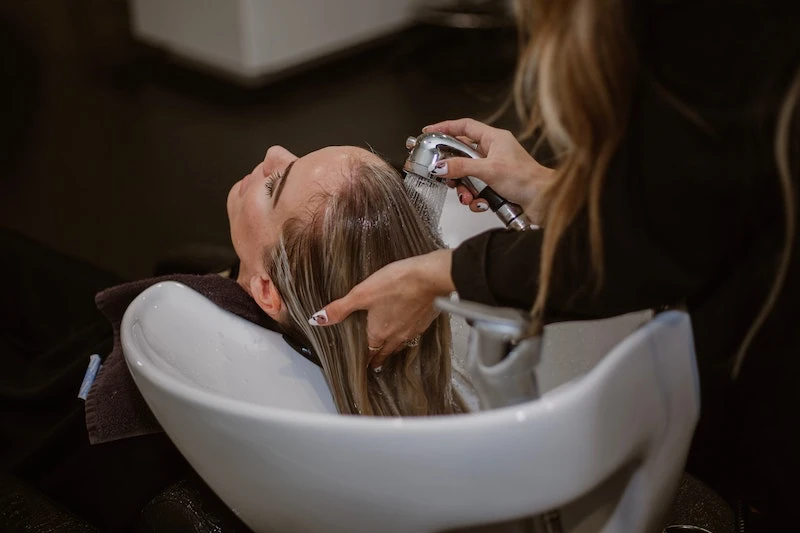
There’s a technical term for this: hygral fatigue. Think of it like bending a paperclip back and forth until it snaps. This is a huge problem, especially for anyone with porous hair from coloring or heat styling, because it just soaks up water like a sponge.
How to Wash and Detangle Like a Pro
Great hair care actually starts before you get it wet. The way you prep and wash your hair can make or break (literally) everything that comes after.
The Pre-Wash Detangle
This is a big one. Unless you have very curly or coily hair, you should always detangle your hair when it’s dry, right before washing. Trying to wrestle with a wet knot is a recipe for disaster. Get yourself a good wide-tooth comb (you can find one for under $10 at any drugstore) or a paddle brush.
Quick Tip: Always start brushing from the ends and gently work your way up to the roots. If you start at the root, you’re just pushing all the tangles down into one giant, impossible knot. This one step alone prevents so much breakage in the shower.

Washing With Purpose
The whole point of shampoo is to clean your scalp, not to scrub the life out of your hair strands. Here’s how we do it in the salon:
- Lather in Your Hands First: Never just plop shampoo directly onto your head. Squeeze a quarter-sized amount into your palms and rub them together with a little water. This creates an even lather before it even touches your hair, making it much gentler.
- Focus on the Scalp: Use the pads of your fingers—never your nails!—to massage the shampoo into your scalp. That’s where the oil and buildup is. The suds running down the length of your hair as you rinse is plenty to clean the strands. No need to pile it all on top of your head in a tangled mess.
- Condition the Ends: After rinsing, gently squeeze the excess water out. Applying conditioner to sopping wet hair just dilutes it and wastes product. Focus the conditioner from the mid-lengths to the ends, since that’s the oldest, driest part of your hair. Let it sit for at least 2-3 minutes to really do its job.
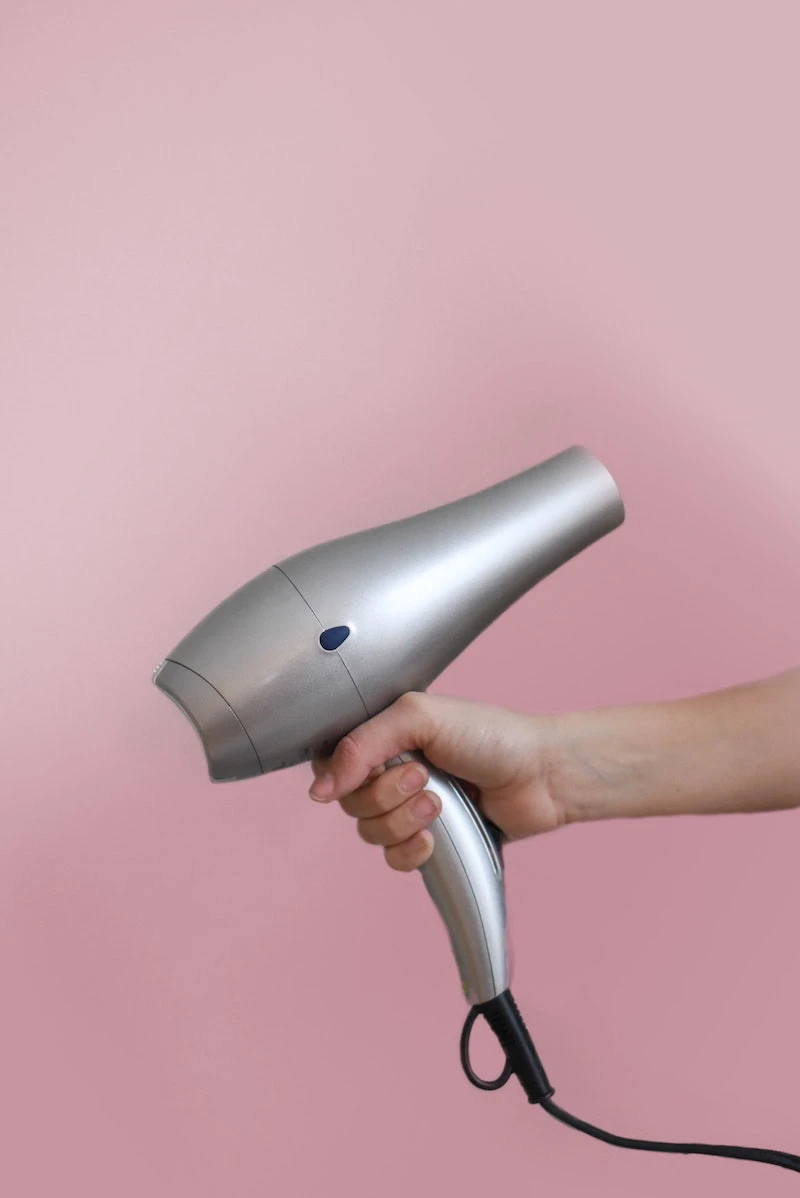
A Note for Curly and Coily Hair
Okay, if you have Type 3 or 4 curls, ignore the dry-brushing rule! Dry brushing will just destroy your curl pattern and cause frizz. For you, the time to detangle is when your hair is sopping wet and loaded with a conditioner that has a lot of “slip.” Use your fingers or a very wide-tooth comb, and just like everyone else, start from the ends and work your way up. Patience is key.
The Art of Drying Without Causing Friction
How you dry your hair is just as critical as how you wash it. The goal is to get the water out gently while encouraging that outer cuticle layer to lie flat and smooth.
Stop Using Your Bath Towel!
That rough, vigorous towel rub? It’s probably the most damaging thing people do to their hair every single day. The coarse loops on a standard cotton bath towel snag on your raised cuticles, creating frizz and tiny tears all along the hair shaft.
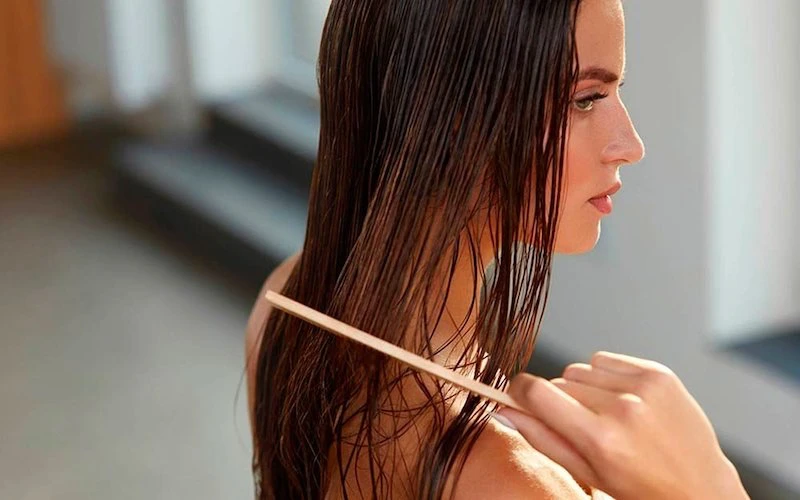
Instead, switch to something smoother. Here’s a quick breakdown:
- A Cotton T-Shirt: This is a fantastic, free upgrade! The fabric is much smoother and won’t snag your hair.
- A Microfiber Towel: This is the best option. These towels are designed to be super absorbent and have a smooth surface that helps reduce frizz and drastically cut down on drying time. You can find a good one online or at stores like Target for between $15 and $25. It’s a worthy investment.
Whatever you use, don’t rub. Gently squeeze and blot the water out. For curly folks, this is where “plopping” comes in. It sounds weird, but it works. Just lay a t-shirt or microfiber towel on your bed, flip your wet, styled curls onto the center of it, then wrap it up to absorb moisture without squishing your curl pattern. Let it sit for 10-20 minutes, and you’re good to go.
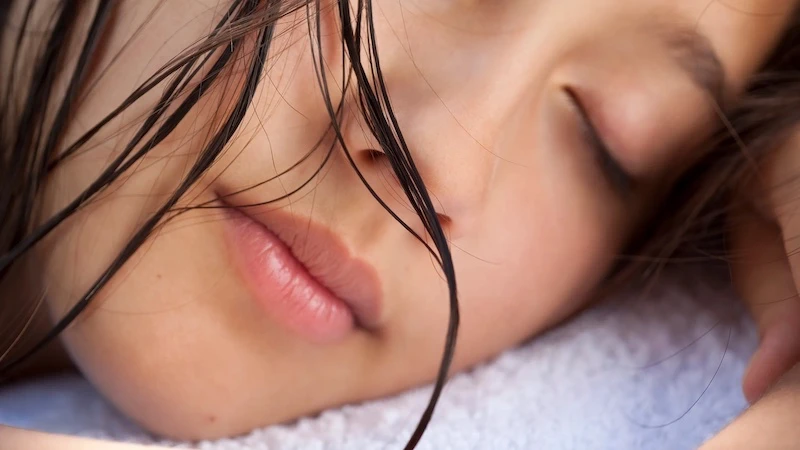
How to Blow Dry Without Frying Your Hair
A blow dryer can be your best friend or your worst enemy. It’s less about the price tag and more about having the right features and using the right technique.
First, the tool itself. You don’t need a $400 pro model, but don’t grab the cheapest thing on the shelf, either. The sweet spot is usually in the $40 to $80 range. For that price, you can get a dryer with the features that actually protect your hair, like ionic technology (which breaks up water faster) and a ceramic or tourmaline body (for even, gentle heat).
Now for the technique. We never just blast hair on high heat.
- Always Use Heat Protectant: This is non-negotiable. It creates a buffer between the heat and your hair. They come in different forms—a lightweight spray is great for fine hair, while a cream might be better for thick or coarse hair.
- Rough Dry to 80% Done: Before you even touch a brush, use your fingers and a medium heat/low speed setting to get your hair about 80% dry. This takes maybe 5-10 minutes and seriously minimizes the time your hair is under direct, high heat.
- Use the Nozzle: That flat attachment that came with your dryer isn’t optional! It concentrates the airflow, giving you control. Always point the dryer down the hair shaft, from root to tip, to help seal the cuticle flat for a shiny finish.
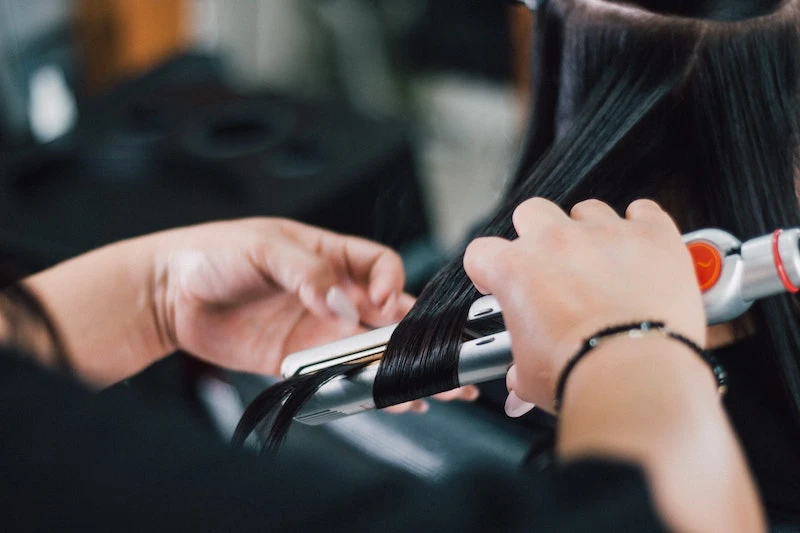
The 3 Biggest Wet Hair Mistakes I See Constantly
Beyond the shower, a few common habits are responsible for so much preventable damage. Are you guilty of any of these?
Mistake 1: Sleeping with Soaking Wet Hair
I get it, you’re exhausted. But going to bed with wet hair is asking for trouble. As you toss and turn, the friction against your cotton pillowcase creates a tangled, matted disaster. Plus, a damp, warm scalp is the perfect environment for fungus to grow, which can lead to dandruff and irritation.
The Fix: Try to get your hair at least mostly dry at the roots before bed. If you must sleep with damp hair, put it in a loose braid or bun and swap your cotton pillowcase for a satin or silk one. A satin pillowcase is a cheap and easy upgrade at around $20, and it makes a huge difference in reducing friction.

Mistake 2: The Tight, Wet Ponytail
Pulling wet hair back into a tight bun or ponytail is a major cause of breakage. Remember how stretchy wet hair is? When you wrench it back with an elastic, you’re putting insane tension on those fragile strands. As it dries and shrinks, the hair inside the band is trapped, and it just snaps. I once had a client who was a swimmer, and I could literally see a halo of breakage circling her head right where her tight, wet bun sat every day. We had to do a big chop to get rid of the damage.
The Fix: If you have to get wet hair off your face, use a large, gentle claw clip. Or, use a soft fabric scrunchie—preferably silk or satin—and keep it very loose. A pack of silk scrunchies is about $15 and they’re so much kinder to your hair.

Mistake 3: Using Hot Tools on Damp Hair
This is the cardinal sin of hair care. NEVER, EVER use a flat iron or curling iron on hair that is not 100% BONE DRY.
That sizzling sound you hear? That’s the water inside your hair shaft flash-boiling, creating explosive steam bubbles that permanently damage the hair from the inside out. I can spot this kind of damage from a mile away; it has a unique, fried look that can’t be repaired. It’s the fastest way to ruin your hair.
The Fix: Be patient. If your hair feels even slightly cool to the touch, it’s still damp. Wait.
A Final Thought…
At the end of the day, think of your hair like a delicate fabric. You wouldn’t throw a silk shirt in a hot dryer, right? It just needs to be handled with a bit of respect for what it is.
And hey, if you feel overwhelmed and don’t know where to start, here’s your quick win. If you do just ONE thing after reading this, make it this: stop using your regular bath towel on your hair. Grab an old t-shirt to gently blot it dry instead. It costs nothing, takes zero extra time, and I promise you’ll notice less frizz almost immediately. It’s these small, smart changes that lead to truly healthy hair.
Inspirational Gallery with Photos
The Towel Showdown: Microfiber vs. The Humble T-Shirt
Aquis Rapid Dry Hair Turban: This cult favorite is made of a proprietary fabric that wicks water away from hair at high speed without roughing up the cuticle. It’s ultra-lightweight, reducing stress on the roots.
Your Old Cotton T-Shirt: The smooth, flat fibers of a cotton tee absorb moisture gently without the friction-causing loops of a traditional terrycloth towel. It’s the ultimate budget-friendly alternative.
Both dramatically reduce friction and drying time, which is the ultimate goal for protecting fragile wet strands.
A single wet hair strand can stretch up to 50% of its original length, but it won’t bounce back. This irreversible stretch is a primary cause of split ends and weakness.
Turn your shower into a mini-spa with a pre-wash treatment. Applying a protective layer *before* shampooing can limit how much water swells the hair shaft, reducing damage. A simple, effective DIY mask:
- Mix two tablespoons of melted, unrefined coconut oil with one tablespoon of honey.
- Apply to dry hair from mid-lengths to ends, avoiding the scalp if you have oily hair.
- Leave on for at least 30 minutes before stepping into the shower.
The big question: Should you really comb your hair in the shower?
Yes, but with a major condition. Hair is weakest when wet, but it’s also when conditioner provides maximum ‘slip,’ making detangling easier. The key is to use the right tool. After applying a generous amount of conditioner, use only a very wide-tooth comb—like the ‘Shower Comb’ from Machete—to gently work through tangles, starting from the ends and moving up toward the roots. Never force it, and never use a brush.
The secret to a ‘glass hair’ finish starts here: That high-gloss shine you crave depends on a smooth, flat cuticle that reflects light. Aggressively rubbing your hair with a towel lifts and damages that cuticle, creating a dull, frizzy surface. Gently squeezing and blotting with a soft fabric is the first, most crucial step to locking in shine before a single styling product is even applied.
The market for ‘bond-building’ hair treatments, popularized by brands like Olaplex and K18, is projected to surpass $1.5 billion by 2028.
These products are formulated to repair the disulfide bonds deep within the hair’s cortex, which are broken by chemical services and extreme stress. While they are incredibly effective for strengthening hair’s core structure, they don’t magically shield the outer cuticle from physical damage. Think of them as repairing the internal framework of a house, but you still need to protect the roof shingles (your cuticles) from a hailstorm—which, in this case, is rough towel drying and aggressive combing when wet.
Rethink the post-shower moment. Instead of a frantic, friction-filled turban twist and a hurried comb-through, treat it as a deliberate act of care. Gently squeeze out excess water, softly blot with a proper towel, and slowly detangle. This small shift in pace not only saves your hair from immense stress but transforms a mundane task into a calming, mindful ritual that sets a gentle tone for the rest of your day.
- Enhances your natural curl or wave pattern without frizz.
- Drastically cuts down on drying time.
- Prevents the crown area from getting flattened by a heavy towel.
The secret is a technique called ‘plopping’. After applying your styling products to soaking wet hair, you lay it gently onto a microfiber towel or cotton t-shirt, then wrap it up onto the top of your head like an accordion. It’s a game-changer for anyone with texture.
For centuries, the practice of hair oiling has been a cornerstone of South Asian beauty rituals, used to protect and nourish hair before washing. This pre-shampoo treatment creates a hydrophobic barrier, preventing the hair shaft from becoming waterlogged and fragile.
- Amla Oil: Rich in Vitamin C, it’s believed to strengthen follicles and add shine.
- Brahmi Oil: Known for its soothing properties, it helps calm the scalp.
- Coconut Oil: Its molecular structure allows it to penetrate the hair shaft, reducing protein loss during washing.
Still reaching for that big, fluffy bath towel? The looped texture of terrycloth, so great for drying your skin, acts like thousands of tiny hooks on your fragile hair strands. This creates friction, lifts the cuticle, and leads directly to frizz and breakage. Your smoothest, softest, old cotton t-shirt is a far superior (and free!) alternative for gently blotting moisture without causing damage.










